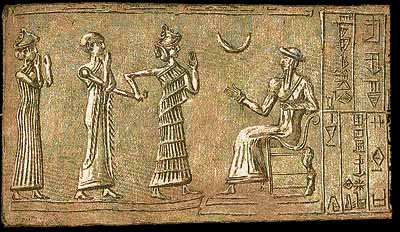




The
moon always was attached to magic, fertility and the secret powers of nature. The moon reflects the
light of sun and stars and therefore was taken as a funnel, collecting energy and pouring it out
over the earth.
The moon is seen as a female planet, a symbol for sensitivity and intuition, and ever since it was
associated with the element of
water. In Chinese mythology the moon is standing for Yin and everything female, and a great
many of moon gods are female.
In old Mesopotamia the Moon (Sîn or Nanna) was a male god, and one of the most important as well. The Moon god was seen as the personification of kindness and wisdom and - and this might seem strange to us - as the father of the Sun god. This will be more understandable considering that the Moon was seen as the patron of the nomads while the Sun rose to prominence with the advent of agriculture - which of course was a development from the former. It is also notable that the first calendars were based on lunar months and not on the solar year.
Sîn (whose name translates as 'Lord of Wisdom') was shown as a horned bull, described as 'the fruit growing by itself', a notion arising from the Moon's regeneration after every waning. His character of being gentle and reliable stems from the fact that the Moon's course is easy to observe and unlike the Sun the Moon never brought unpleasant things to the world (like for example draughts). His connection with water as a life-giver of paramount importance for the region.

In ancient Egypt the Moon was equated with the god Thoth as the god of wisdom and science. Thoth
was also in charge of the calendar which still was based on lunar months. Yet in Egypt the Moon
slowly lost his 'leadership' over the Sun and was finally seen as having been created by the Sun
god Ra to illuminate the nocturnal sky.
Other prominent Egyptian Moon gods were Chonsu and Khepera, while the latter was at times seen as a
Sun god.
Notwithstanding the Moon's everlasting association to wisdom and the steady rhythm of waxing and
waning, of death and rebirth it was soon associated with feminity. The female menstruation seems to
go with the Moon like the tides of the seas.
Another reason for the advent of female Moon godesses might have been the wish to create a
counterpart to the male Sun god, having both genders represented by the two most prominent
celestial bodies.
The Greek associated the Moon with Selene, the daughter of the archaic Titans Hyperion and Theia. Being seen both as the godess of the Moon and the Moon herself she is depicted as a beautiful woman driving a silver chariot across the sky every night in much the same manner as her brother Helios drives his sun chariot during the day. Selene carries a torch and wears a shining crown which casts a soft silvery light upon the dark world. Note that Selene and Helios are described as siblings here, once again stressing the tight relationship between Sun and Moon. The third sibling was Eos, the godess of the dawn.
